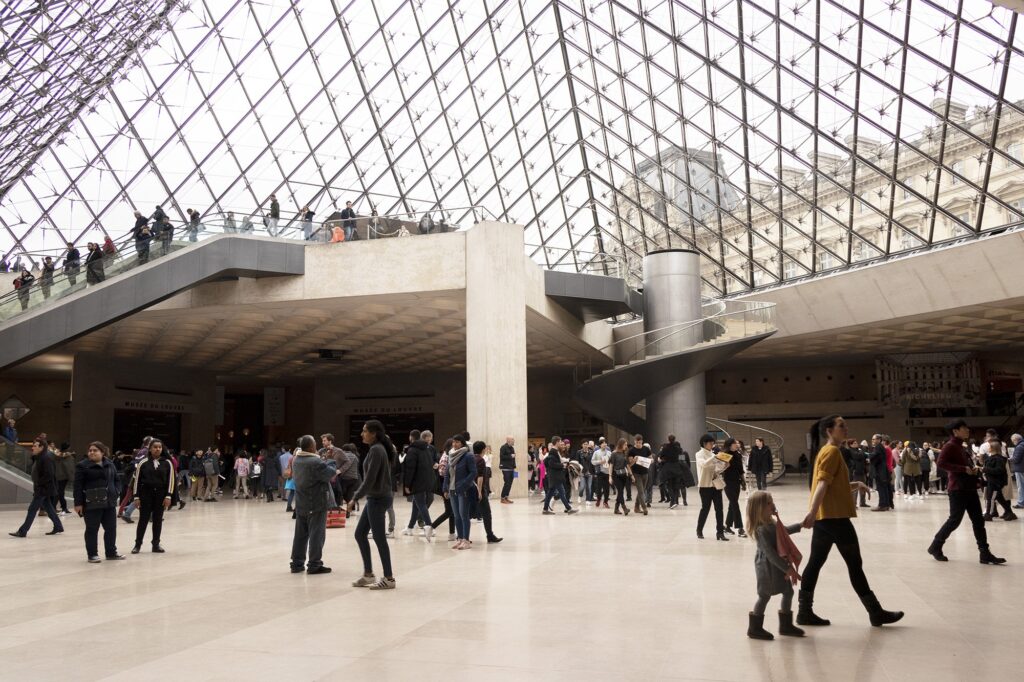
Introduction
The Louvre is the expression of representation and revolution about past human history, about arts that are time and age. Louvre’s great epitome in representing Paris, France, at one end, is the actual great museum of Paris. Now it is one of the world’s greatest museums in space with 380,000 objects and thousands upon thousands in similar ways not in any sense with those kinds of icons of national cultural heritage that are long established to welcome the general public coming from every nook and corner of this world on earth one million visitors within a year.

Let’s take you through history and architectural changes and also some great works of art contained in this grand palace; let’s learn more about the wonder by a wide number of questions asked across the world.
History Louvre Museum
- Country: France
- City: Paris
- Year est.: 1793
- Number of visitors 2023 More than 9.6 million.
- Collections Over 380,000
- Some of its world-known Masterpieces Artwork: the Mona Lisa, Venus de Milo, Victory Winged of Samothrace, The Coronation of Napoleon
Evolution of Fortification Architecture
The Louvre was originally built as a fortress at the end of the half of the 12th century by King Philip II. Time had changed its purpose into becoming a military fortress only because it was targeted to the Viking invasion that sought up the Seine River into the city of Paris for safekeeping.
Last but not the least, it became a military fortress, and later changed into a royal palace.
Restored as a royal place by King Francis I of France, it made this place in the 16th century; he had ideas with work for this. Costly apartments in itself, along with great wonder architecture and collection of artistic items formed a museum in Louvre where stood bright excellence or, in what is referred as a Renaissance period. For, in those times, there was beauty in a culture, and there are pretty cultures, so it must have many.

It was opened as an official public museum under the French Revolution in 1793. Its first collection was made from confiscated works of art by the monarchy and nobility. The collection had to be educational and enlightening for it to represent the revolutionary ideal. Collections were amassed by buying and accepting donations from all directions of art during varying periods and regions within nearly two centuries and following decades.
Architectural Development
Louvre’s architectural design portrays every phase of its history. Outside, it shows the ancient appearance experienced in the underground fortress referred to colloquially as “Louvre Castle” – strictly a medieval castle buried beneath the soil of the museum. Louvre architecture presents some of its outstanding productions up to date and the glass pyramid is included in it. The Glass Pyramid project was ordered by I.M. Pei, year 1989. It has automatically created space within the museums that it disputes, within the classical forms of its surrounding buildings.

International Acclaim and Artistic Heritage
Louvre has been one of the leading centres since the 19th and 20th centuries till date, one of the institutions holds the utmost importance as far as culture and the arts are concerned. All these art forms, from the very first human being up to this present time, raise so many questions that an artist, a historian, or just a simple art viewer does wonder and reflect on with further determination in the search for and the classification of work of art. Since it still holds history, the Louvre has always been very careful while taking care of and has distributed publicity to every country feeling it as their cultural sign of international heritage.
Collections of The Louvre
Collections within the Louvre can be categorized into further eight sections. These further sections talk about art and history in each field. Following are some examples for these eight categories:
Antiquities from Near Eastern
This includes the following: antiquities from ancient Mesopotamia, Persia, and Anatolia fall under Near Eastern antiquities. In the list, the most exquisite of all things include clay tablets, cylinder seals, and monumental sculptures. Fine examples of the works of famous pieces of Assyria include the Code of Hammurabi and Winged Bulls.

Egyptian Antiquities
This place is also home to the greatest collection, aside from Egypt. Not only does the list begin with mummies down to sarcophagi and even simple articles like the ancient civilization of Egyptians, but among the few are Nefertiti’s bust and a statue of Ramses II.
Greek, Etruscan and Roman antiquities
It possesses the oldest pieces for statues, vases, and ornaments depicting ancient days. Other pieces are full of particular technological miracles; there are Venus de Milo and Winged Victory of Samothrace. All of them place it in a position where it ranks third place as evaluated for the year 1907 because of museums created from all over the globe; according to the World Association of Masters of Masonry.

Islamic Art
Is illustrated with ceramics and applied arts of the countries, whose textile is decorated by Islamic tradition and manuscripts of the Islamic world; it speaks to viewers about the artistic successes of cultures embracing forming the Islamic tradition.
Sculptures
Sculptural collection includes Renaissance and Baroque. Among all of creations, there’s also another remarkably beautiful series Slaves.
This comes under decorative arts and encompasses furniture, ceramics, and tapestries. Under the present list, above Crown Jewels of France fall in the following paintings.

Paintings
The number of paintings in this world is greater and that makes such an impression on human creativity through the best creations by the most acclaimed artists all over the world. Among the list of the most important representatives of painting art are such giants as Leonardo da Vinci, Raphael and Rembrandt. One of them for instance is where millions of people visit this place each year. Among the most popular works, is the Mona Lisa.

Prints and Drawings
It houses prints and drawings and therefore encompasses much of the work on paper. It can identify itself with drawings, prints, and illuminated manuscripts. That apart, it can hold developments that take place in print-making and potential roles that the drawing can take.

Other than that, there are thousands of experiences waiting to be freed out for the visitor but that has remained as a home of art. Some of the experiences from the visitors include guided tours, as stated;
- Guided tours by people who have been dwelling inside the Louvre museum and these individuals happen to be resourceful and in categories of one’s interest: general collection highlights, theme, and more.
- Learning programs: There are for both children and adults. From this point, education goes a step ahead and offers the visitor training not only in appreciating art but also in history. It incorporates lectures as well as classroom practices on the art as well as hands-on exercises on it.
- Loan exhibitions: The Louvre will display permanent temporary exhibitions that comment on issues relevant to the artists, movements, or topics. This implies that one might find some of those works in other museums.
- Accessibility: The Louvre would take care of its collections with love as if loving every person there. The house would consider someone’s disability while offering guided tours, touch as well as sound exhibitions besides translated audio guides in all major languages.
FAQS of the Louvre Museum
What is the Timings of the Louvre Museum?
The Louvre Museum is open throughout the year except for Tuesday and some holidays. Normally, its time ranges between 9 AM to 6 PM, but from Wednesday to Friday, it opens and functions up to 9:45 PM.
How much is a ticket for the Louvre?
Online. The ticket price is from €17 for an adult and €15 at the museum. Everyone under 26 enters for free as well as those who are citizens of the European Union. The last one, everyone under the age of 18 is free.
Is it necessary to book tickets in advance?
Though it is possible to get the ticket at the door, booking is advisable. Standing in a queue for an hour or more wastes one portion of the waiting time for permission to get into the Louvre. When getting an online ticket, even a tourist can also access the Louvre through some other exit.
What is the best time to visit the Louvre?
The Louvre must be visited on a weekday. The perfect thing is the timing in the morning or the late afternoon when that falls off-peak, particularly for winter as then there will be fewer queues and one may manage to avoid the sometimes unavoidable very long lines during the Louvre off-peak periods.
Can I take photographs inside the Louvre?
Most of the museum can be photographed except that absolutely no flash is permitted, no tripods or selfie sticks. Would not obstruct somebody’s view, and was not allowed to touch the artwork.
Can one eat in the museums, cafeterias, or other refreshment places?
Yes, there are, Food and Beverages that have stretches along all stations alongside the Louvre and all these have a dining room. You can dine inside the very style Café Marly that covers one full side of the ground on one side of the end face of the pyramid. It fills in ahead of the view into the pyramid, therefore all complete restaurant clientele may enjoy a brilliant view of the courtyard.
Is this restaurant available to be accessed by people using wheelchair?
Very sensitive to persons with disability and contains facts that host either ramps or elevators for easy paths meant for visiting persons on a wheelchair. Visits: other facilities make provision for an arm on guided visitors of tour visits either by making accessibility possible to the wheelchair user or supporting a partially fit individual on an aid -crutches, wheelchair as amongst others.
What should I not miss when visiting the Louvre?
One never leaves the place without casting a glance over at least some of the ‘highlights’: say Mona Lisa, Venus de Milo, Winged Victory of Samothrace and the Coronation of Napoleon. Architecture isn’t forgotten.
Conclusion
Louvre is much more a collection of art instead of the fact of which it holds in its concept, rather being in its sense regarding the value which it considers for the related art. For the simple reason that it remains one heck of a testimony concerning the human ability to be so creative, while, of course, being curatorial about history in its self-context within the culture itself.
It is why the Louvre’s depth that it is taking care of interest in learning makes this a place of a liberally open institution where anyone like that kind of historian – an admirer of multiple arts in different forms does become a true beneficiary and such abundance that has is offered in return for it.
Louvre incidentally turns out to be the treasure house of human achievement through art and that will turn out to be the world’s largest and mark a great point regarding the powerful durability of grand art. It might well be an interesting walk up the corridors of the Louvre or appreciating a masterpiece. In any case, though, spending time in that ambiance basking marks a visit to Louvre time and creativity.






